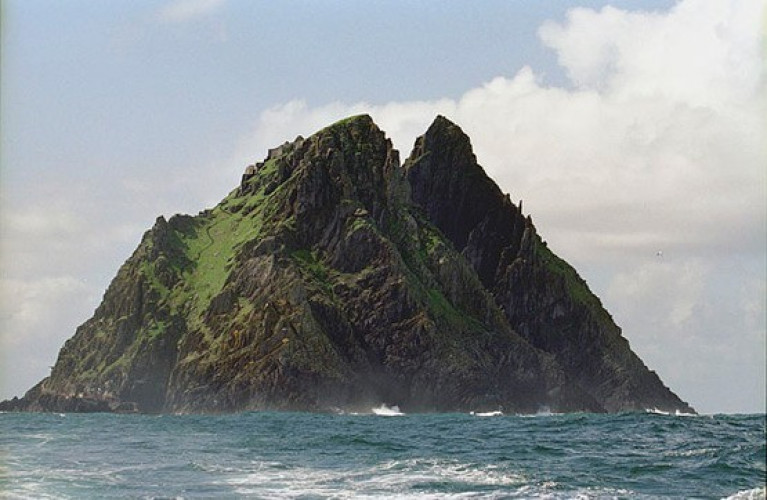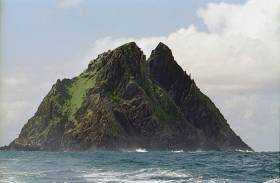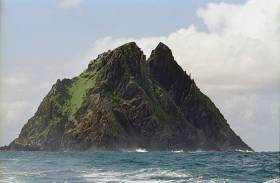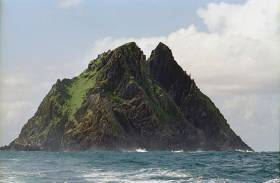Displaying items by tag: Skellig Michael
Skellig Michael Opening Deferred
Skellig Michael's re-opening to visitors has been deferred to July 1st due to weather and sea conditions, the Office of Public Works (OPW) has said.
The OPW had set a target date of June 21st for the 2021 season, but says that this has been put back "owing to recent poor weather and sea conditions off the south west coast.
"This target date was dependent on favourable weather conditions, allowing preparatory safety works to progress in a timely manner prior to opening," the OPW said today.
"Unfortunately, due to periods of poor weather conditions hampering the progress of work on-site, the re-opening of Skellig Michael has now been postponed,"it said.
Subject to weather, the opening will take place on July 1st.
OPW guides sought urgent talks several weeks ago about the re-opening date, as the announcement was made when consultations were still underway on health and safety issues related to Covid-19.
The pandemic and a serious rockfall last summer meant that the UNESCO world heritage site was closed to visitors throughout 2020.
Donal McCrohan, chairman of the Skellig Boatmen’s Association, said that the 15 licensed operators serving Skellig Michael have been informed they can take their maximum of 12 passengers.
McCrohan, who runs Skellig Coast Adventures, said that bookings were brisk but there was still good availability.
The OPW had advised visitors watch a safety video to prepare for a trip to Skellig Michael, which is on www.heritageireland.ie
Guides on Skellig Michael are concerned about lack of consultation over the decision to re-open to visitors from June 21st.
As The Times Ireland edition reports, guides employed by the Office of Public Works (OPW) are concerned about the manner in which the re-opening was announced.
They also fear the OPW has not taken adequate steps to limit visitor numbers in the light of the Covid-19 pandemic.
The Unesco world heritage site was closed to all visitors last year due to the health and safety considerations linked to Covid-19, and the fact that a serious rockfall occurred last July near the guide accommodation – in which no one was injured.
Early last week, Minister of State with responsibility for the OPW Patrick O’Donovan confirmed a target date of June 21st for this season’s re-opening.
He said it would be subject to weather conditions, and completion of preparatory health and safety works by OPW crews.
However, guides understood that health and safety consultations with management were still taking place when he made his announcement.
"It’s not at all safe,” a source close to the guides confirmed.
“There was no guide representative involved or consulted before they made the decision to open, and critical agreements were made with boatmen - although it is the guides who have the job of managing visitor safety and being first responders in the complex circumstances of this season,” the source said.
“The whole industry around the Skellig depends on the role of the guides in the front line of the island, and the lack of consideration for both guides and visitors is unforgivable," the source added.
Donal McCrohan, chairman of the Skellig Boatmen’s Association, said that the 15 licensed operators serving Skellig Michael have been informed they can take their maximum of 12 passengers.
He said the fleet based mainly in Portmagee and several other Kerry harbours has been preparing its own safety protocols in conjunction with an industry professional.
McCrohan, who runs Skellig Coast Adventures, said that ferry trips were outdoors where the ventilation rate would be “exceptional”.
He said that passengers would be required to complete a Covid-19 questionnaire.
McCrohan said that though bookings were brisk, there was still very good availability, and prices for his trips were retained at 2019 levels.
The OPW said it had “set a target date of June 21st to reopen Skellig Michael to visitors, and this is subject to all preparatory works on the site being completed in time”.
“A health and safety plan for reopening is not yet complete and engagement with all concerned parties is currently under way,” it said.
“ OPW has also advised the local boatmen who carry visitors to the island of the target date. While the boatmen are licensed to land on the island, health and safety arrangements on the boats are entirely a matter for the boat operators,” the OPW added.
Read The Times here
Skellig Michael may re-open to visitors from June 21st, according to Minister of State for the Office of Public Works (OPW) Patrick O’Donovan.
The midsummer opening for the UNESCO world heritage site off Kerry will be subject to weather conditions, and completion of preparatory health and safety works by OPW crews, Donovan said today.
As Afloat reported last month, the 15 licensed ferry operators for Skellig Michael were told that visits would be permitted this season within Covid-19 guidelines.
The sixth-century monastic site was closed to all visitors last year due to the health and safety considerations linked to the pandemic, and a serious rockfall last July near the guide accommodation – in which no one was injured.
The OPW has been reopening heritage and cultural sites this season under the Government’s road map.
It advises that intending visitors should consult HeritageIreland.ie for updates ahead of planning their visit.
“I am very pleased to be able to share this much-anticipated good news with holidaymakers eager to visit Skellig Michael this summer and with the rural communities who rely on tourism to the island,” Donovan said.
“I myself look forward to visiting this unique UNESCO World Heritage Site soon and I hope that weather conditions will allow OPW staff to complete the required preparatory works so the reopening can go ahead on June 21st,”he said.
“Thanks to the progress we have made on the path to recovery, we will have the opportunity to discover and enjoy national treasures such as these over the coming months,”he added.
Skellig Michael Boatmen Optimistic for Mid-June Re-opening of UNESCO World Heritage Site
Skellig Michael ferry operators are hoping that the UNESCO world heritage site may re-open to visitors from mid-June.
As The Times Ireland edition reports, the sixth-century monastic site off the Kerry coast was closed to all visitors last year due to Covid-19 health and safety considerations.
Donal McCrohan, chairman of the Skellig Boatmen’s Association, told The Times Ireland that the re-opening in June is “provisional”, but the 15 licensed operators are optimistic that visits will be permitted.
Last year’s closure by the Office of Public Works (OPW) was extended for the entire summer season after a serious rockfall last July near the guide accommodation – in which no one was injured.
The OPW has been reopening heritage and cultural sites this season under the Government’s road map, but has not made an announcement to date on Skellig Michael.
However, McCrohan said that the 15 licensed ferry operators running trips to the rock 12km off the Kerry coast were told at a meeting last Friday that mid-June was being examined..
McCrohan said he would be accepting provisional bookings for visits from later this week.
Ferry operator John O’Shea, who runs trips to and around Skellig Michael from Caherdaniel, Co Kerry, said that he and his colleagues had been told they would be given a more definite date by late May.
O’Shea said he is taking bookings from mid-June and will offer a refund for landing trips if the island is closed.
O’Shea is one of several operators who will still run “non-landing” trips around Skellig Michael and Little Skellig this season, which work out at half the cost of landing trips.
It is understood OPW staff have not been given any date as yet for return.
McCrohan said the logistics on visits had not been discussed in detail last week, but he said the boatmen’s association is preparing its own risk assessment for the sea trip and landing.
Last year, ferry operators had proposed a protocol that would involve checking passengers for symptoms, requiring use of face masks and reduced numbers to meet social distancing requirements.
However, the OPW believed the need for cleaning and sanitisation and social distancing on ferries in rough weather – and on the island - would prove too challenging.
The OPW was unable to comment.
Read The Times Ireland here
Boat Operators Vow To ‘Come Back With A Bang’ As Skellig Michael Is Closed To Visitors This Season
Skellig Michael will not be reopened to visitors this season due to concerns around the spread of coronavirus, the OPW has confirmed.
But as The Irish Times reports, the decision which followed a promised assessment after the island was closed in May has left local boat operators disappointed, but not surprised.
“There are a few operators doing sea angling trips but the landing trips [on to Skellig Michael] are the bread and butter for most of us,” said Donal McCrohan, chairman of the Skelligs Boatmen’s Association.
“We would have liked to get going ahead but it is what it and this is the outcome and I suppose we just have to look forward to 2021 and come back with a bang.”
Yesterday (Thursday 30 July) the OPW said it had taken the decision not to reopen the island off the Kerry coast due to the risks involved in both the boat passage to the island and visiting the island itself amid the ongoing coronavirus pandemic.
The Unesco World Heritage site features prominently in the second instalment of the recent Star Wars film trilogy, which concluded in cinemas this past Christmas.
The Irish Times has more on the story HERE.
Former Skellig Michael Site Manager Says Star Wars Film Shoot Was ‘Inappropriate’
Skellig Michael’s former site manager has expressed his misgivings around filming for the Star Wars movie franchise at the Unesco World Heritage site.
As the Irish Examiner reports, Grellan Rourke — who recently retired from his role after 41 years — gave a lecture at UCD where he discussed the challenges of maintaining the Co Kerry island, which is both an early Christian monastic site as well as an important sanctuary for marine wildlife.
Speaking on filming for The Force Awakens and The Last Jedi, Rourke observed: “The whole thing was very professional but in a way, I think it is inappropriate to use a site like that for commercial filming.”
He also suggested that filmmakers could have digitally recreated the island and its surrounds without “putting anything in jeopardy”.
And he noted how the popularity of the films and demand for fans to visit the location has brought the island’s limited boat trips to full capacity — as well as changing the public perception of the place.
“It’s sad in one way, the real history of the place, over 1,400 years, that the real history is set to one side and the more recent make-believe is to the fore,” he said.
The Irish Examiner has much more on the story HERE.
An Taisce Speaks Out Over ‘Cultural Rebranding’ Of Skellig Michael
#StarWars - Tourism chiefs’ “cultural rebranding” of Skellig Michael on the back of its appearance in the new Star Wars film threatens to push visitor numbers to “unsustainable levels”, says An Taisce.
According to The Irish Times, Ireland’s national trust has urged new Culture Minister Josepha Madigan to review the impact of both filming activity and tourism at the UNESCO World Heritage site — and put a temporary halt on any future commercial filming on the Kerry coastal island.
The centrepiece of Tourism Ireland’s latest campaign for the Wild Atlantic Way, Skellig Michael has experienced a sharp rise in visitors since its link with the Star Wars movie franchise.
This has prompted concern in some quarters over the sustainability of an important heritage site and sanctuary for protected seabirds.
The Irish Times has more on the story HERE.
Wild Atlantic Way Features In ‘Space Tourism’ Campaign
#StarWars - Tourism Ireland’s latest ad campaign for the Wild Atlantic Way has gone literally stratospheric, as RTÉ News reports.
Skellig Michael is front and centre in what Irish tourism chiefs are calling their ‘first space tourism campaign’, which saw a billboard sent more than 33km skywards on a weather balloon.
The brief clip aims to capitalise on the growing hype for the new Star Wars film The Last Jedi, in which the UNESCO World Heritage site features prominently.
It’s not the first time Tourism Ireland has pushed the Kerry coastal island as a destination for Star Wars fans, and visitor numbers have skyrocketed since it appeared at the end of the previous instalment in the film saga two years ago.
But The Last Jedi, which opens next week, is expected to boost interest in other parts of the Wild Atlantic Way, too, with various scenes shot in picturesque spots between Cork and Donegal.
OPW Mulls Over Extension To Skellig Michael Visitor Season
#SkelligMichael - Skellig Michael’s visitor season, which closes today (Tuesday 3 October), may be extended to cater for “exceptional” demand.
RTÉ News reports that the Office of Public Works (OPW) has confirmed it is reviewing a possible extension to the season, which currently runs from May to October each year.
Visitor numbers to the Co Kerry island have skyrocketed since its appearance in the new Star Wars film series.
Skellig Michael will be a central location in Star Wars: The Last Jedi, opening in cinemas around the world in mid December.
The newfound popularity of ‘Star Wars Island’ has not come without controversy, however.
Figures show nearly 14,700 tourists landed on the island in 2016 — more than 10,000 over what’s considered sustainable in the approved management plan for the UNESCO World Heritage site.
Rockfalls and other winter storm damage delayed the opening of the 2017 visitor season by a number of days, while raising concerns about the impact of tourist landings on the vulnerable site.
Meanwhile, the length of the current landing season has been challenged by a boatman on the route, who took issue with the move of the opening date from the traditional 30 March to mid May.
Skellig Boatman In Court Action Over Landing Limits
#SkelligMichael - Skellig Islands boatman Sean ‘Seanie’ Murphy has brought a High Court action over limits on the visitor season at Skellig Michael, as BreakingNews.ie reports.
Murphy claims the move by the Department of Transport, Tourism and Sport to move the opening of the season from the traditional 30 March to mid May, when the island is staffed, has reduced the summer landing period by a third.
He also argues that the Transport Minister is not entitled to determine the length of the landing season, noting that the decision — apparently taken on health and safety advice from the National Monument Service, which staffs the island — was made without consultation with boatmen who ply the route to the island off the Kerry coast.
Poor weather postponed the opening of the island to visitors till this past Thursday 18 May, as RTÉ News reports, after earlier concerns that unstable rocks on the island would cause further delays.
Previously, another boatman challenged the loss of his landing permits at the Unesco World Heritage site that’s set for a tourism boom with its connections to the new Star Wars film series.



































































